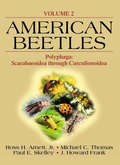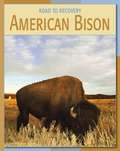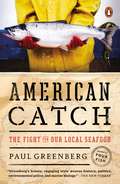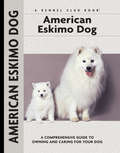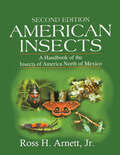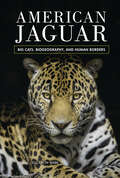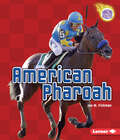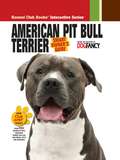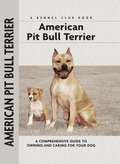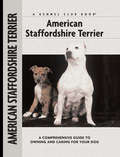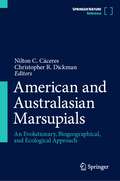- Table View
- List View
American Alligator: Ancient Predator in the Modern World
by Kelby OuchleyHaving survived since the Mesozoic era, alligators teetered on the brink of extinction in the 1960s. Their recovery in the 1970s was largely due to legislative intervention, and today populations are closely monitored throughout their range. American Alligator is the most up-to-date and comprehensive treatment of this resilient relic, a creature with a brain weighing less than half an ounce that has successfully adapted to a changing Earth for more than 200 million years.Kelby Ouchley chronicles the evolution of A. mississippiensis from "shieldcroc"--the last common ancestor of modern-day alligators, crocodiles, caimans, and gavials--to its current role as keystone of the ecological health of America's southern swamps and marshes. In Florida, the apex predator uses its snout and feet to clear muck from holes in the limestone bedrock. During the dry season, these small ponds or "alligator holes" provide refuge, food, and water for a variety of wildlife. In Louisiana, millions of dollars are spent on the bounty of the non-native nutria that overgraze marsh vegetation, but alligators prey on these coastal rodents free of charge.The loss of the American alligator would be a blow to biodiversity and an ecosystem disruption affecting all levels of the food chain. While the U.S. Fish and Wildlife Service removed it from the endangered species list in 1987 and today regulates the legal trade of the animal and its products, Ouchley cautions us not to forget the lessons learned: human activities, from urban development to energy production, can still threaten the future of the gator and its southern wetland habitat.
American Beetles, Volume I: Archostemata, Myxophaga, Adephaga, Polyphaga: Staphyliniformia
by Jr. Ross H. Arnett Michael C. ThomasA thorough update of Arnett's The Beetles of the United States, American Beetles, Volumes I and II cover the genera of beetles that occur in Alaska, Canada, and the contiguous United States. Built on the foundation of the original work and almost completely rewritten with contributions from more than 60 coleopterists, these volumes describe each fa
American Beetles, Volume II: Polyphaga: Scarabaeoidea through Curculionoidea
by J. Howard Frank Ross H. Arnett Michael C. Thomas Paul E. SkelleyExperts offer the most sweeping reference available on the subject of North American beetles. Their rigorous standards for the presentation of data create a concise, useful format that is consistent throughout the book. This is the resource of choice for quick, accurate, and easily accessible information.
American Bison (Road to Recovery)
by Barbara A. SomervillThe American bison was hunted to near extinction in the 1800s as settlers moved west across what is now the United States. Readers will learn about this animal that is a symbol of the American West and find out what steps were taken to help increase the American bison population.
American Bison: A Natural History
by Dale F. LottThis book, sixth in the series of 'Organisms and environments', presents a peek at the rich and unique ways of life that evolved in the heart of America and dismantles many of the myths about these ways of life, and about the bison in particular, to reveal the animal itself: ruminating, reproducing, and rutting in its full glory. He portrays the bison with an element of appeal to conserve its wildness and consider the importance of the wild in our lives. A beautifully written book by a recognized expert on one of the great icons of the American West.
American Bulldog
by Wil Deveer Abe FishmanOnce a well-kept secret in the United States, the American Bulldog is now one of the nation's most celebrated canine exports, establishing a devoted following around the globe. This Comprehensive Owner's Guide is dedicated to the American Bulldog, a breed that was once used as a ranch and farm dog but today excels as a companion and protection dog. Author Abe Fishman provides a controversial but wholly candid retelling of the breed's history and its re-creation in the United States. The history chapter is followed by a chapter devoted to the characteristics of this exceptional working breed, offering sound advice about which owners are best suited to this vigorous and active canine.New owners will welcome the well-prepared chapter on finding a reputable breeder and selecting a healthy, sound puppy. Chapters on puppy-proofing the home and yard, purchasing the right supplies for the puppy as well as house-training, feeding, and grooming are illustrated with photographs of handsome adults and puppies. In all, there are over 135 full-color photographs in this useful and reliable volume. The author's advice on obedience training will help the reader better mold and train into the most well-mannered dog in the neighborhood. The extensive and lavishly illustrated chapter on healthcare provides up-to-date detailed information on selecting a qualified veterinarian, vaccinations, preventing and dealing with parasites, infectious diseases, and more. Sidebars throughout the text offer helpful hints, covering topics as diverse as historical dogs, breeders, or kennels, toxic plants, first aid, crate training, carsickness, fussy eaters, and parasite control. Fully indexed. .
American Catch
by Paul GreenbergINVESTIGATIVE REPORTERS & EDITORS Book Award, Finalist 2014 <P><P>In American Catch, award-winning author Paul Greenberg takes the same skills that won him acclaim in Four Fish to uncover the tragic unraveling of the nation's seafood supply--telling the surprising story of why Americans stopped eating from their own waters. In 2005, the United States imported five billion pounds of seafood, nearly double what we imported twenty years earlier. Bizarrely, during that same period, our seafood exports quadrupled. <P><P>American Catch examines New York oysters, Gulf shrimp, and Alaskan salmon to reveal how it came to be that 91 percent of the seafood Americans eat is foreign. In the 1920s, the average New Yorker ate six hundred local oysters a year. Today, the only edible oysters lie outside city limits. Following the trail of environmental desecration, Greenberg comes to view the New York City oyster as a reminder of what is lost when local waters are not valued as a food source. Farther south, a different catastrophe threatens another seafood-rich environment. <P><P>When Greenberg visits the Gulf of Mexico, he arrives expecting to learn of the Deepwater Horizon oil spill's lingering effects on shrimpers, but instead finds that the more immediate threat to business comes from overseas. Asian-farmed shrimp--cheap, abundant, and a perfect vehicle for the frying and sauces Americans love--have flooded the American market. Finally, Greenberg visits Bristol Bay, Alaska, home to the biggest wild sockeye salmon run left in the world. A pristine, productive fishery, Bristol Bay is now at great risk: The proposed Pebble Mine project could under¬mine the very spawning grounds that make this great run possible. In his search to discover why this precious renewable resource isn't better protected, Green¬berg encounters a shocking truth: the great majority of Alaskan salmon is sent out of the country, much of it to Asia. Sockeye salmon is one of the most nutritionally dense animal proteins on the planet, yet Americans are shipping it abroad. <P><P>Despite the challenges, hope abounds. In New York, Greenberg connects an oyster restoration project with a vision for how the bivalves might save the city from rising tides. In the Gulf, shrimpers band together to offer local catch direct to consumers. And in Bristol Bay, fishermen, environmentalists, and local Alaskans gather to roadblock Pebble Mine. With American Catch, Paul Greenberg proposes a way to break the current destructive patterns of consumption and return American catch back to American eaters.
American Eskimo Dog
by Richard G. BeauchampThe magnificent snow-white coated American Eskimo Dog is the focus of this Comprehensive Owner's Guide, a book that celebrates the appealing personality, unmistakable intelligence, and captivating beauty of this made-in-America spitz breed. Serving as a complete introduction to the breed, long recognized by the United Kennel Club and more recently by the American Kennel Club, this book discusses the breed's evolution in the United States, the special characteristics of the breed, and both the AKC and UKC breed standards.New owners will welcome the well-prepared chapter on finding a breeder and selecting a healthy, sound puppy. Chapters on puppy-proofing the home and yard, purchasing the right supplies for the puppy as well as house-training, feeding, and grooming are illustrated with handsome adults and puppies bursting with attitude and personality! In all, there are over 135 photographs in this compact, useful, and reliable volume. The author's advice on obedience training the smart (but not too eager to please) American Eskimo will help readers better mold and train their dogs into the most socialized, well-mannered Eskie in the neighborhood. The extensive chapter on healthcare provides up-to-date detailed information on selecting a qualified veterinarian, vaccinations, parasites, infectious diseases, and more. Chapters on showing and participating in dog sports as well as solving common behavior issues (such as barking, aggression, digging, etc.) will prove informative and helpful to the new owner. Sidebars throughout the text offer helpful hints, covering topics as diverse as historical kennels, toxic plants, first aid, crate training, carsickness, fussy eaters, and parasite control. Fully indexed.
American Insects: A Handbook of the Insects of America North of Mexico, Second Edition
by Ross H. Arnett Jr.Offering a complete accounting of the insects of North America, this handbook is an up-dated edition of the first handbook ever compiled in the history of American entomology.By using American Insects, A Handbook of the Insects of America North of Mexico, Second Edition, readers can quickly determine the taxonomic position of any species, genus, or
American Jaguar: Big Cats, Biogeography, and Human Borders
by Elizabeth WebbIn the borderlands between the United States and Mexico, America's largest cat—the jaguar—is fighting to regain its kingdom. Added to the endangered species list in 1997, the jaguar has declined in population mainly due to habitat fragmentation created by roads, farms, mines, and most controversially, the border wall. Such human-made barriers prevent free movement of many wild animals for predation and mating, thereby threatening their reproduction, DNA transfer, and overall survival. Author and wildlife biologist Elizabeth Webb examines the jaguar's predicament and highlights the work of field scientists who are searching for solutions. "Conservation Connection" features throughout the book underscore the importance of protecting this keystone species of the Americas.
American Pests: The Losing War on Insects from Colonial Times to DDT
by James McWilliamsThe world of insects is one we only dimly understand. Yet from using arsenic, cobalt, and quicksilver to kill household infiltrators to employing the sophisticated tools of the Orkin Man, Americans have fought to eradicate the "bugs" they have learned to hate. Inspired by the still-revolutionary theories of Rachel Carson's Silent Spring, James E. McWilliams argues for a more harmonious and rational approach to our relationship with insects, one that does not harm our environment and, consequently, ourselves along the way. <P><P>Beginning with the early techniques of colonial farmers and ending with the modern use of chemical insecticides, McWilliams deftly shows how America's war on insects mirrors its continual struggle with nature, economic development, technology, and federal regulation. He reveals a very American paradox: the men and women who settled and developed this country sought to control the environment and achieve certain economic goals; yet their methods of agricultural expansion undermined their efforts and linked them even closer to the inexorable realities of the insect world. As told from the perspective of the often flamboyant actors in the battle against insects, American Pests is a fascinating investigation into the attitudes, policies, and practices that continue to influence our behavior toward insects. Asking us to question, if not abandon, our reckless (and sometimes futile) attempts at insect control, McWilliams convincingly argues that insects, like people, have an inherent right to exist and that in our attempt to rid ourselves of insects, we compromise the balance of nature.
American Pharoah (Amazing Athletes Ser.)
by Jon M FishmanIn 2015, racehorse American Pharoah won the Kentucky Derby, the Preakness Stakes, and finally the Belmont Stakes to become the first Triple Crown winner since 1978. The three-year-old horse with the misspelled name thrilled racing fans with his powerful and graceful running. As the 12th Triple Crown winner in history and the first in 37 years, American Pharoah joined an elite group of champions. Read all about the life of a legendary racehorse.
American Pharoah: The Untold Story of the Triple Crown Winner's Legendary Rise
by Joe DrapeHistory was made at the 2015 Belmont Stakes when American Pharoah won the Triple Crown, the first since Affirmed in 1978. As magnificent as the champion is, the team behind him has been all too human while on the road to immortality.Written by an award-winning New York Times sportswriter, American Pharoah is the definitive account not only of how the ethereal colt won the Kentucky Derby, Preakness, and Belmont Stakes, but how he changed lives. Through extensive interviews, Drape explores the making of an exceptional racehorse, chronicling key events en route to history. Covering everything from the flamboyant owner's successful track record, the jockey's earlier heartbreaking losses, and the Hall of Fame trainer's intensity, Drape paints a stirring portrait of a horse for the ages and the people around him.
American Pharoah: Triple Crown Champion
by Shelley Fraser MickleFrom the author of Barbaro comes the triumphant story of the 2015 Triple Crown and Breeders Cup winner, American Pharoah.When American Pharoah won the American Triple Crown and the Breeders’ Cup Classic in 2015 he became the first horse to win the “Grand Slam” of American horse racing, by winning all four races. His story captured American’s imagination, and this inspired account will also feature the handlers who saw his promise: owner, Ahmed Zayat of Zayat Stables, trainer Bob Baffert, and jockey Victor Espinoza. With American Pharoah, Shelley Mickle tells the story of this beloved horse’s life from birth to his historic achievement of becoming the twelfth Triple Crown winner.
American Pit Bull Terrier
by Dog Fancy MagazineSmart Owners Guide: American Pit Bull Terrier is the first interactive breed book of it kind to offer new and novice owners a fun new way to learn about caring for their loyal companions. American Pit Bull Terrier offers the most up-to-date online support with instant access to Club Club APBTTM where owners can meet and interact with other dedicated Pit owners, download charts and checklists, play Pit-specific games, take quizzes, and send themed e-cards. The book contains easy-to-read, informative content, with addition smart tips, notable quotations, fun facts, and more than 100 adorable breed photos that keep you flipping through the pages.
American Pit Bull Terrier
by F. FavoritoThis Comprehensive Owner's Guide to the American Pit Bull Terrier serves as a complete introduction to the dog who can do virtually anything, regarded by his owners as the smartest, most devoted, and most versatile dog in existence. Despite the breed's controversial beginnings as a fighting dog and reams of bad press it has garnered in contemporary times, lovers of the APBT defend the breed as one of the true red, white, and blue originals, worthy of high praise for its flawless devotion. Author F. Favorito sits firmly in this camp and details the breed's origins without apology, offering fascinating insight and detail that all breed lovers will relish. The author continues with chapters on characteristics and the breed standard encapsulating all of the virtues of this one-of-a-kind working terrier breed, offering sound advice about which owners are best suited (and worthy) to own this potentially challenging breed.New owners will welcome the well-prepared chapter on finding a breeder and selecting a healthy, sound puppy. Chapters on puppy-proofing the home and yard, purchasing the right supplies for the puppy as well as house-training, feeding, and grooming are illustrated with handsome adults and puppies bursting with energy and personality! In all, there are over 135 photographs in this compact, useful, and reliable volume. The author's advice on obedience training the ever-ready Pit Bull will help readers better mold and train their dogs into the most socialized, well-mannered bully in the neighborhood. The extensive chapter on healthcare provides detailed information on selecting a qualified veterinarian, vaccinations, parasites, infectious diseases, and more. Sidebars throughout the text offer helpful hints, covering topics as diverse as toxic plants, bloat, first aid, crate training, carsickness, fussy eaters, and parasite control. Fully indexed.
American Serengeti: The Last Big Animals of the Great Plains
by Dan FloresAmerica's Great Plains once possessed one of the grandest wildlife spectacles of the world, equaled only by such places as the Serengeti, the Masai Mara, or the veld of South Africa. Pronghorn antelope, gray wolves, bison, coyotes, wild horses, and grizzly bears: less than two hundred years ago these creatures existed in such abundance that John James Audubon was moved to write, "it is impossible to describe or even conceive the vast multitudes of these animals." In a work that is at once a lyrical evocation of that lost splendor and a detailed natural history of these charismatic species of the historic Great Plains, veteran naturalist and outdoorsman Dan Flores draws a vivid portrait of each of these animals in their glory--and tells the harrowing story of what happened to them at the hands of market hunters and ranchers and ultimately a federal killing program in the nineteenth and twentieth centuries. The Great Plains with its wildlife intact dazzled Americans and Europeans alike, prompting numerous literary tributes. American Serengeti takes its place alongside these celebratory works, showing us the grazers and predators of the plains against the vast opalescent distances, the blue mountains shimmering on the horizon, the great rippling tracts of yellowed grasslands. Far from the empty "flyover country" of recent times, this landscape is alive with a complex ecology at least 20,000 years old--a continental patrimony whose wonders may not be entirely lost, as recent efforts hold out hope of partial restoration of these historic species. Written by an author who has done breakthrough work on the histories of several of these animals--including bison, wild horses, and coyotes--American Serengeti is as rigorous in its research as it is intimate in its sense of wonder--the most deeply informed, closely observed view we have of the Great Plains' wild heritage.
American Snakes
by Sean P. GrahamThe captivating and beautifully illustrated true story of snakes in America.125 million years ago on the floodplains of North America, a burrowing lizard started down the long evolutionary path of shedding its limbs. The 60-plus species of snakes found in Sean P. Graham's American Snakes have this ancestral journey to thank for their ubiquity, diversity, and beauty. Although many people fear them, snakes are as much a part of America's rich natural heritage as redwoods, bald eagles, and grizzly bears. Found from the vast Okefenokee Swamp to high alpine meadows, from hardwood canopies to the burning bottom of the Grand Canyon, these ultimate vertebrates are ecologically pivotal predators and quintessential survivors.In this revelatory and engaging meditation on American snakes, Graham, a respected herpetologist and gifted writer, • explains the everyday lives of American snakes, from their daily routines and seasonal cycles to their love lives, hunting tactics, and defensive repertoires• debunks harmful myths about snakes and explores their relationship with humans• highlights the contribution of snakes to the American wilderness• tells tales of "snake people"—important snake biologists with inspiring careersNeither a typical field guide nor an exhaustive reference, American Snakes is instead a fascinating study of the suborder Serpentes. Brimming with intriguing and unusual stories—of hognose snakes that roll over and play dead, blindsnakes with tiny vestigial lungs, rainbow-hued dipsadines, and wave-surfing sea-snakes—the text is interspersed with scores of gorgeous full-color images of snakes, from the scary to the sublime. This proud celebration of a diverse American wildlife group will make every reader, no matter how skeptical, into a genuine snake lover.
American Snakes
by Sean P. Graham“A wonderful book to read because it is replete with snake stories, personal stories, and stories about other herpetologists . . . engaging.” —CopeiaAlthough many people fear them, snakes are as much a part of America’s rich natural heritage as redwoods, bald eagles, and grizzly bears. Found from the vast Okefenokee Swamp to high alpine meadows, from hardwood canopies to the burning bottom of the Grand Canyon, these ultimate vertebrates are ecologically pivotal predators and quintessential survivors.In this revelatory and engaging meditation on American snakes, Sean P. Graham, a respected herpetologist and gifted writer,explains the everyday lives of American snakes, from their daily routines and seasonal cycles to their love lives, hunting tactics, and defensive repertoiresdebunks harmful myths about snakes and explores their relationship with humanshighlights the contribution of snakes to the American wildernesstells tales of “snake people”—important snake biologists with inspiring careersNeither a typical field guide nor an exhaustive reference, American Snakes is instead a fascinating study of the suborder Serpentes. Brimming with intriguing and unusual stories—of hognose snakes that roll over and play dead, blindsnakes with tiny vestigial lungs, rainbow-hued dipsadines, and wave-surfing sea-snakes—the text is interspersed with scores of gorgeous full-color images of snakes, from the scary to the sublime. This proud celebration of a diverse American wildlife group will make every reader, no matter how skeptical, into a genuine snake lover.“This thoroughly enjoyable book lets readers absorb the excitement of being a herpetologist who works with snakes while learning about the general and specific biology of the creatures.” —Quarterly Review of Biology
American Staffordshire Terrier
by Joseph JanishThis Comprehensive Owner's Guide to the American Staffordshire Terrier serves as a complete introduction to the AmStaff, a tireless working dog that is an unbeatable combination of strength and athleticism. Deriving from bull and terrier crosses in the British Isles, the American Staffordshire Terrier was honed and perfected in the USA and today enjoys a reputation as a wholly trustworthy family and children's companion, top-flight show dog, formidable contender in the obedience ring, and a wonderful therapy dog. Author Joe Janish shares his insight into the origins of the breed and its development in America in a well-researched opening chapter on breed history. He follows with chapters on characteristics and the breed standard encapsulating all of the virtues of this impressive working breed, offering sound advice about which owners are best suited to the breed.New owners will welcome the well-prepared chapter on finding a breeder and selecting a healthy, sound puppy. Chapters on puppy-proofing the home and yard, purchasing the right supplies for the puppy as well as house-training, feeding, and grooming are illustrated with handsome adults and puppies bursting with energy and personality! In all, there are over 135 photographs in this compact, useful, and reliable volume. The author's advice on obedience training the super smart AmStaff will help readers better mold and train their dogs into the most socialized, well-mannered dog in the neighborhood. The extensive chapter on healthcare written by Dr. Lowell Ackerman provides up-to-date detailed information on selecting a qualified veterinarian, vaccinations, parasites, infectious diseases, and more. Further chapters discuss behavioral issues (aggression, digging, barking, etc.), the special care of senior dogs, and showing and competing with the AmStaff in AKC events. Sidebars throughout the text offer helpful hints, covering topics as diverse as historical kennels, toxic plants, first aid, crate training, carsickness, fussy eaters, and parasite control. Fully indexed.
American Water Spaniel
by Paul R. MorrisonA Yankee Doodle original, the American Water Spaniel hails from the state of Wisconsin, where in the town of New London Dr. F. J. Pfeifer developed this all-around sporting dog that could retrieve and flush for the upland hunter. Medium in size and colored in chocolate or liver, the American Water Spaniel excels as both a retriever and a spaniel. Author Paul R. Morrison, an active AWS breeder and sportsman, traces the breed's origins back to Civil War days, chronicling the many legends that have evolved about this curly-coated field spaniel. A friendlier, smarter hunting companion cannot be found-the AWS remains one of America's best kept secrets. This Special Limited Edition also discusses the breed's characteristics as a family dog and hunting dog, his personality and abilities and the breed standard. Each chapter is illustrated with color photographs, making this volume as handsome as it is comprehensive and useful. Chapters on selecting a breeder and puppy, rearing and training the puppy, grooming, feeding and much more provide the owner with a complete guide to this fun-loving spaniel. The book also provides an excellent introduction to dog showing and trialing, sports that welcome enthusiastic newcomers on a weekendly basis. A special chapter on preventive healthcare, written by renowned veterinarian Dr. Lowell Ackerman, provides up-to-date, accurate information on inoculations, parasites, spaying/neutering and much more.
American Wolf: A True Story of Survival and Obsession in the West
by Nate BlakesleeThe enthralling story of the rise and reign of O-Six, the celebrated Yellowstone wolf, and the people who loved or feared her <P><P>Before men ruled the earth, there were wolves. Once abundant in North America, these majestic creatures were hunted to near extinction in the lower 48 states by the 1920s. But in recent decades, conservationists have brought wolves back to the Rockies, igniting a battle over the very soul of the West. With novelistic detail, Nate Blakeslee tells the gripping story of one of these wolves, O-Six, a charismatic alpha female named for the year of her birth. <P><P>Uncommonly powerful, with gray fur and faint black ovals around each eye, O-Six is a kind and merciful leader, a fiercely intelligent fighter, and a doting mother. She is beloved by wolf watchers, particularly renowned naturalist Rick McIntyre, and becomes something of a social media star, with followers around the world. <P><P>But as she raises her pups and protects her pack, O-Six is challenged on all fronts: by hunters, who compete with wolves for the elk they both prize; by cattle ranchers who are losing livestock and have the ear of politicians; and by other Yellowstone wolves who are vying for control of the park’s stunningly beautiful Lamar Valley. <P><P>These forces collide in American Wolf, a riveting multigenerational saga of hardship and triumph that tells a larger story about the ongoing cultural clash in the West—between those fighting for a vanishing way of life and those committed to restoring one of the country’s most iconic landscapes.
American Zoo
by David GrazianOrangutans swing from Kevlar-lined fire hoses. Giraffes feast on celebratory birthday cakes topped with carrots instead of candles. Hi-tech dinosaur robots growl among steel trees, while owls watch animated cartoons on old television sets. In American Zoo, sociologist David Grazian takes us on a safari through the contemporary zoo, alive with its many contradictions and strange wonders. Trading in his tweed jacket for a zoo uniform and a pair of muddy work boots, Grazian introduces us to zookeepers and animal rights activists, parents and toddlers, and the other human primates that make up the zoo's social world. He shows that in a major shift away from their unfortunate pasts, American zoos today emphasize naturalistic exhibits teeming with lush and immersive landscapes, breeding programs for endangered animals, and enrichment activities for their captive creatures. In doing so, zoos blur the imaginary boundaries we regularly use to separate culture from nature, humans from animals, and civilization from the wild. At the same time, zoos manage a wilderness of competing priorities--animal care, education, scientific research, and recreation--all while attempting to serve as centers for conservation in the wake of the current environmental and climate-change crisis. The world of the zoo reflects how we project our own prejudices and desires onto the animal kingdom, and invest nature with meaning and sentiment.A revealing portrayal of comic animals, delighted children, and feisty zookeepers, American Zoo is a remarkable close-up exploration of a classic cultural attraction.
American and Australasian Marsupials: An Evolutionary, Biogeographical, and Ecological Approach
by Nilton C. Cáceres Christopher R. DickmanThis book focuses on the ecology, evolution, biogeography, systematics and taxonomy of New World and Australasian marsupials, greatly expanding the current knowledge base. There are roughly 140 species of New World marsupials, of which the opossum is the best known. Thanks to recent research, there is now an increasing amount of understanding about their evolution, biogeography, systematics, ecology, and conservation in the Americas, especially in South America. There are also some 270 marsupial species in the Australasian region, many of which have been subject to research only in recent years. Based on this information and the authors’ extensive research, this book provides comprehensive insights into the world's marsupials. It will appeal to academics and specialized researchers, students of zoology, paleontology, evolutionary biology, ecology, physiology and conservation, as well as interested non-experts.
Ami Ami Kittens: Seriously Cute Crochet!
by Mitsuki HoshiThe third colorful and imaginative installment in the illustrated amigurumi series, following Ami Ami Dogs and Ami Ami Dogs 2. Amigurumi, which translates to knitted stuffed toy in Japanese, is the art of crocheting cute stuffed animals with large heads and small bodies. Ami Ami Kittens is packed with projects for all crochet lovers offering them directions and inspiration for creating a range of fun and irresistible yarn kittens. Detailed, easy-to-follow instructions, illustrations, and enchanting color photographs teach them how to create these super adorable felines of various breeds and types, including Tabby, Pointed, Black/White Solid, Black and White, Calico, Scottish Fold, Siamese, Russian Blue, Munchkin, Maine Coon, British Shorthair, and American Shorthair. Here, too, are instructions for transforming them into key chains, finger puppets, and magnets. Ami Ami Kittens covers a wide range of techniques, from basic crochet skills perfect for beginners to more challenging patterns for experts, and offers spiral methods to ensure that the stuffing stays inside the finished piece. Filled with pretty, fun, and irresistibly adorable young cats, Ami Ami Kittens provides hours of fun for every knitter-and cat lovers, too.


